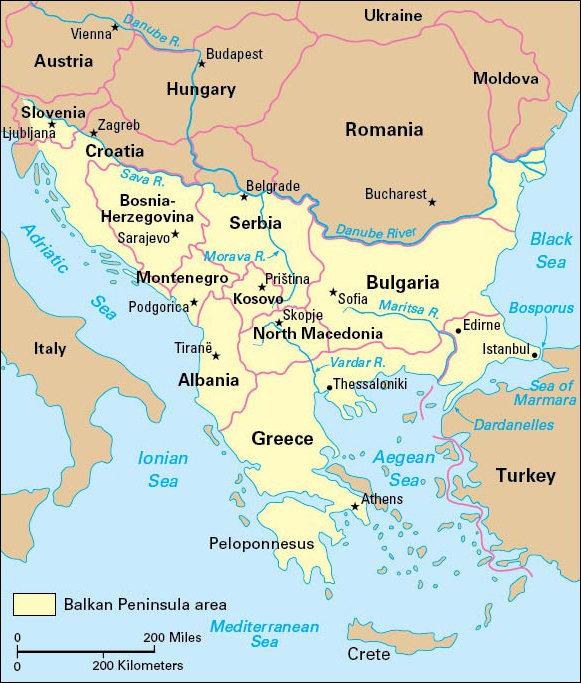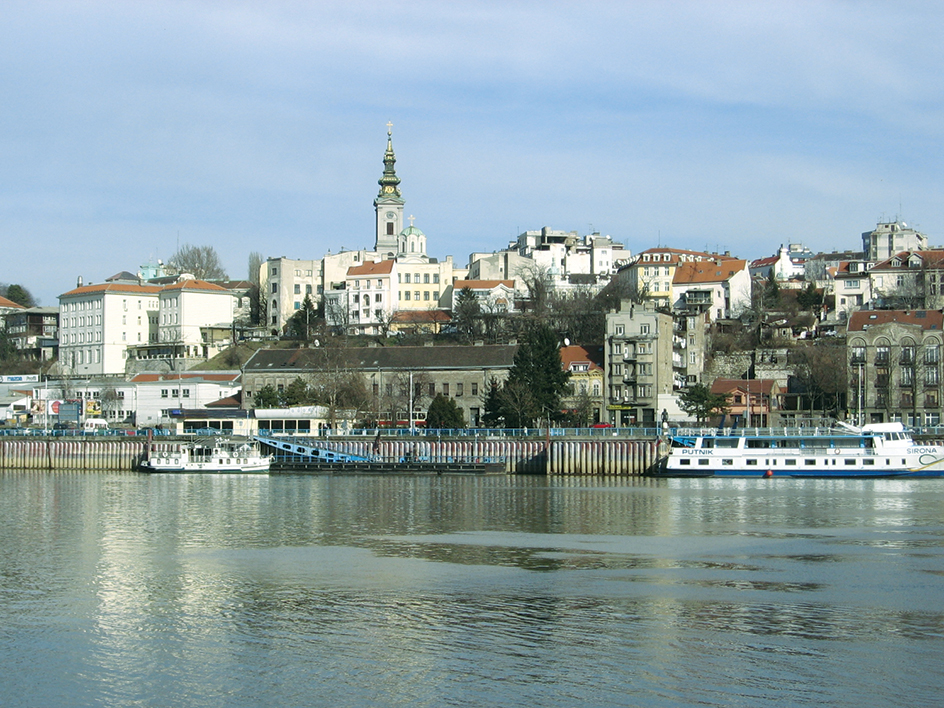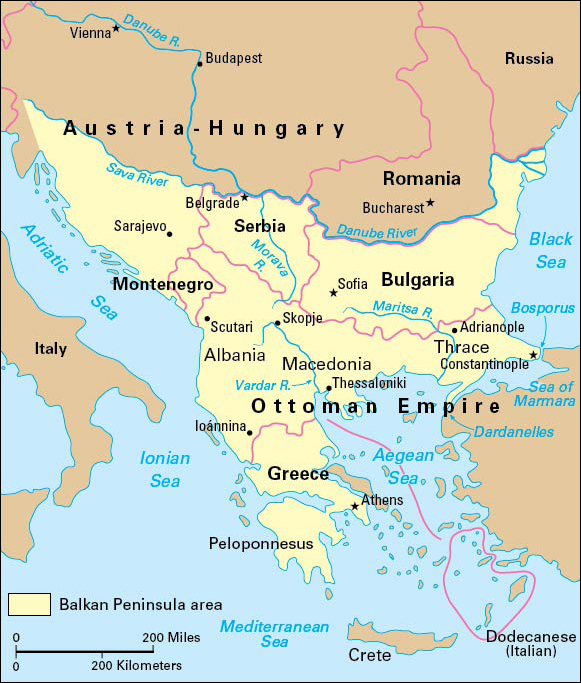Balkans are a group of countries that cover a peninsula in the southeast corner of Europe. Balkan is a Turkish word meaning mountain. The Balkans include several mountain ranges. The region has been called the Powder Keg of Europe because many wars have begun there.
Location, size, and description.
The Sava and Danube rivers form the northern boundary of the Balkan Peninsula. The Black Sea and the Bosporus border it on the east. The southern boundary is formed by the Sea of Marmara, the Dardanelles, and the Aegean Sea. The Adriatic and Ionian seas lie to the west. 
The Balkan Peninsula covers about 184,000 square miles (477,000 square kilometers). It includes Albania, Bosnia-Herzegovina, Bulgaria, Kosovo, North Macedonia, Montenegro, the mainland of Greece, the European part of Turkey (eastern Thrace), and parts of Croatia, Serbia, and Slovenia. Most of Romania is not a geographic part of the peninsula. But Romania is often considered a Balkan country because of its close ties with the region in history and politics.
Mountains cover much of the peninsula. The Dinaric Alps extend through Croatia along the Adriatic Sea to Greece, where they are called the Pindus Mountains. The Balkan Mountains stretch from the eastern border of Serbia across Bulgaria. The Rhodope Mountains rise in southern Bulgaria. The Danube River is the area’s chief commercial waterway. Other important rivers are the Morava, Vardar, and Maritsa.
People.
The chief nationalities of the Balkan Peninsula include Albanians, Bosnians, Bulgarians, Croats, Greeks, Macedonians, Romanians, Serbs, and Turks. About half of the peninsula’s people live in rural areas, and about half live in urban areas. The major cities are Athens, Greece; Belgrade, Serbia; Bucharest, Romania; Istanbul, Turkey; and Sofia, Bulgaria.
Early history.
The Roman Empire held the peninsula for over 500 years, beginning about 148 B.C. The Slavs came into the area in the A.D. 500’s. By the late 1300’s, the Ottoman Empire held most of the peninsula. 
In the 1800’s, the Balkan peoples, spurred by feelings of nationalism, began to seek independence. The great European powers—including Austria-Hungary, France, and the United Kingdom—encouraged Balkan nationalism for their own purposes. From 1829 to 1908, first Greece and then Montenegro, Serbia, Romania, and Bulgaria gained their independence from the Ottoman Empire. But all the people of one nationality did not live in the same country. The Congress of Berlin in 1878 recognized the independence of Montenegro, Romania, and Serbia. The Ottoman Empire continued to hold Macedonia and Albania. See Berlin, Congress of .
The First Balkan War.
The newly independent states wanted to free the entire Balkan Peninsula from Ottoman rule. In October 1912, war broke out between the Ottoman Empire and four of the Balkan states: Bulgaria, Greece, Montenegro, and Serbia. In November, Albania declared its independence from the Ottoman Empire. The Ottomans asked for a truce in December.

The Balkan countries demanded that the Ottomans withdraw from almost all of their European possessions. The empire refused, and the war resumed in February 1913. The coalition defeated the Ottoman Empire, and on May 30, 1913, the empire signed the Treaty of London, giving up nearly all its territory in Europe. Albania was recognized as an independent country. Bulgaria took Adrianople (now Edirne, Turkey). Serbia gained large areas in Macedonia. Greece gained Crete and other islands, Thessaloniki, and part of Macedonia. See London, Treaties of (The Treaty of 1913) .
The Second Balkan War.
Bulgaria had done most of the fighting against the Ottomans. However, it did not receive as much territory in Macedonia as it had been promised in a secret treaty of alliance before the war. Serbia had taken control of the promised territories during the war and did not want to give them up. So Bulgaria attacked Serbian as well as Greek positions in Macedonia in June 1913. Romania, Montenegro, and the Ottoman Empire then joined the Serbs and the Greeks in fighting the Bulgarians.
Less than a month after the fighting started, the Bulgarians asked for peace. Under the Treaty of Bucharest, signed on Aug. 10, 1913, Bulgaria lost much of the territory it had taken from the Ottoman Empire in the first war, keeping only western Thrace and a small corner of Macedonia. The Ottomans regained Adrianople, with eastern Thrace. The Balkan wars sowed deep bitterness among the people of Macedonia and Bulgaria. Albanians in the Kosovo region of Serbia also felt wronged because they came under Serbian rule despite their desire to be part of the new country of Albania. See Bucharest, Treaty of .
World War I (1914-1918)
started in the Balkan Peninsula. Bulgaria and the Ottoman Empire were the only Balkan powers on the side of Germany and Austria-Hungary. France became a leading ally of the Balkans during the war. See World War I.
After the war, Serbia, Montenegro, and territories north of them were combined into a kingdom that later became Yugoslavia. The Ottoman Empire was abolished in 1922, and the nation of Turkey was formed in 1923 from the empire’s remaining territories.
World War II (1939-1945).
Bulgaria joined Germany and Italy in World War II. Bulgaria occupied the Yugoslav (Serbian) part of Macedonia and a part of northern Greece. Germany and Italy occupied the rest of Greece and Yugoslavia. Albania was occupied by Italy and later by Germany. Turkey remained neutral during most of the war. Until October 1944, Germany and Italy controlled most of the peninsula. See World War II .
After World War II, all the Balkan countries except Greece and Turkey fell under Communist rule. Greece and Turkey became allies of the United States and members of the North Atlantic Treaty Organization (NATO).
Communist rule.
The Communist governments in Albania, Bulgaria, Romania, and Yugoslavia closely followed the model of the Soviet Union. These governments took control of industry and, except for Yugoslavia, of agriculture. They outlawed all political parties other than the Communist party, imposed censorship, conducted antireligious campaigns, and used secret police to enforce obedience. In Greece, Communist rebels fought for nearly five years to seize control of the country, but they were finally defeated.
Yugoslavia’s leader, Josip Broz Tito, refused to let the Soviet Union control his country. In 1948, Soviet leader Joseph Stalin expelled Yugoslavia from the Soviet-led Cominform organization and cut all ties between the countries. After Stalin’s death, the two countries reestablished relations, but Yugoslavia remained independent.
By the end of the 1970’s, the Balkan states faced high unemployment and civil unrest. In the late 1980’s and early 1990’s, Communist governments throughout Europe collapsed. Albania, Bulgaria, Romania, and Yugoslavia adopted multiparty political systems.
Recent developments.
In Yugoslavia, the Serbian leader Slobodan Milosevic sought to extend Serbia’s dominance. In 1991 and 1992, four republics of Yugoslavia—Bosnia-Herzegovina, Croatia, Macedonia (later to be renamed North Macedonia), and Slovenia—declared their independence. War broke out between Serbs and non-Serbs, and Yugoslavia broke apart. Milosevic and others waged violent campaigns for ethnic domination. In 1999, NATO air strikes helped end Serbian military attacks on ethnic Albanians in the Serbian province of Kosovo. In 2000, Milosevic lost power. In 2003, Yugoslavia officially became Serbia and Montenegro. Montenegro and Serbia separated and became independent nations in 2006. In 2008, Kosovo declared independence from Serbia. For details, see the articles on the individual Balkan countries.
